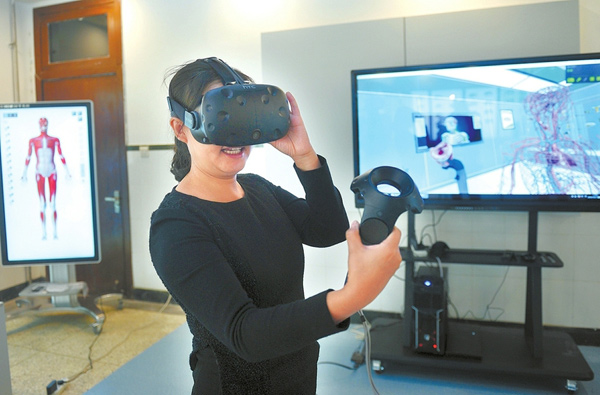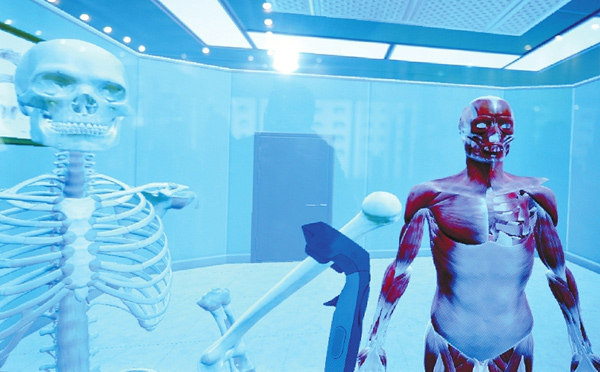


A teacher shows the students how to observe the human body structure at the VR anatomy course. (Photo/West China Metropolis Daily)

The VR image of human body. (Photo/West China Metropolis Daily)
The awards ceremony for the 2016 First Season VRCORE Hardcore VR Developer Tournament was held in Beijing on Oct. 18. The VR version of a 3-D anatomy course developed by Sichuan University won the best application award, and was also nominated for the best trans-boundary award. The technology innovatively displays the human body for medical students.
In the Simulation Anatomy course at West China Foundation Medicine and Forensics School of Sichuan University, a student wearing VR glasses stood in front of the screen as the teacher narrated what the student was seeing. Students in the class could not only observe the organs and structures of the human body through VR technology, they could also could “pick up” an organ and put it near their eyes to observe.
It took five years for the research team to develop this VR anatomy course. Anatomy is an essential course for all medical students. However, the lack of human specimens has caused difficulties in teaching the subject. Ideally, five or six students share one human specimen, but in many medical schools dozens of students are forced to share.
Some schools use atlases and dummies for teaching. However, the three-dimensional interior structures of the human body are hard to convey through two-dimensional illustrations.
Wang Fan, a medical professor from Sichuan University, offered an example. According to Wang, when doing craniocerebral operations, the doctor must know the structure and layout of cerebral vessels. This is hard to describe through words, and hard for students to understand without seeing the actual human brain. VR technology can help students to observe important structures and vessels.
Li Hua, vice dean of the West China Foundation Medicine and Forensics School of Sichuan University, said that the school’s VR anatomy course has successfully digitized the human body. It is a good example of the fruitful intersection of medicine and computer technology.
 Fire brigade in Shanghai holds group wedding
Fire brigade in Shanghai holds group wedding Tourists enjoy ice sculptures in Datan Town, north China
Tourists enjoy ice sculptures in Datan Town, north China Sunset scenery of Dayan Pagoda in Xi'an
Sunset scenery of Dayan Pagoda in Xi'an Tourists have fun at scenic spot in Nanlong Town, NW China
Tourists have fun at scenic spot in Nanlong Town, NW China Harbin attracts tourists by making best use of ice in winter
Harbin attracts tourists by making best use of ice in winter In pics: FIS Alpine Ski Women's World Cup Slalom
In pics: FIS Alpine Ski Women's World Cup Slalom Black-necked cranes rest at reservoir in Lhunzhub County, Lhasa
Black-necked cranes rest at reservoir in Lhunzhub County, Lhasa China's FAST telescope will be available to foreign scientists in April
China's FAST telescope will be available to foreign scientists in April "She power" plays indispensable role in poverty alleviation
"She power" plays indispensable role in poverty alleviation Top 10 world news events of People's Daily in 2020
Top 10 world news events of People's Daily in 2020 Top 10 China news events of People's Daily in 2020
Top 10 China news events of People's Daily in 2020 Top 10 media buzzwords of 2020
Top 10 media buzzwords of 2020 Year-ender:10 major tourism stories of 2020
Year-ender:10 major tourism stories of 2020 No interference in Venezuelan issues
No interference in Venezuelan issues
 Biz prepares for trade spat
Biz prepares for trade spat
 Broadcasting Continent
Broadcasting Continent Australia wins Chinese CEOs as US loses
Australia wins Chinese CEOs as US loses